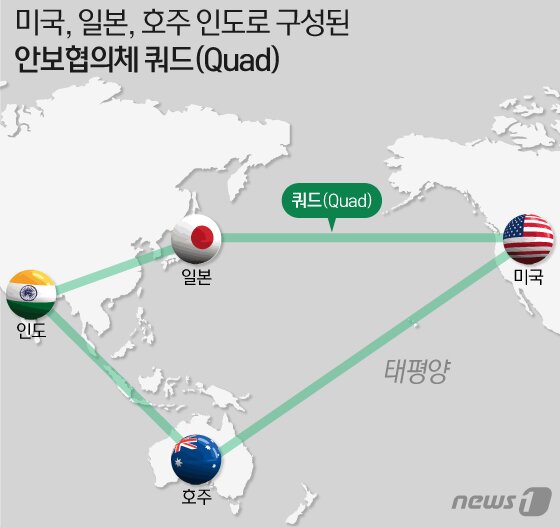 |
| © News1 Designer Lee Ji-won |
It was officially confirmed by the announcement of the White House on the 9th (local time) that the first summit meeting of Quad, a consultative body between the United States, Japan, Australia and India, will be held on the 12th. It is analyzed that India’s position that was burdensome to participate in the quad was largely due to the conclusion of the summit meeting.
The quad summit, which was promoted by the US at the beginning of last month, was sluggish because of India, which was uncomfortable with the’targeted at China’ quad. India has a tradition of advocating non-aligned neutralism and refusing to belong to one camp. India’s non-cooperation was also cited as the cause of the misrepresentation of a joint statement at the quad foreign ministers’ meeting last October.
Then, in March, news of the quad summit was confirmed. India’s position has changed.
The Financial Times (FT) cited the remarks of Anza Manuel Aspen, Director of the Security Forum, that India’s attempts to break away from its non-alignment policy to counter-attack China have caused a “great turnaround”.
A bloody border conflict with China greatly contributed to the change in attitude. The two countries, which had been in a border dispute for a long time, had conflicted at Pangoncho in Ladakh last May and continued conflict until this year.
Border conflict led to trade regulation. India has banned the use of Chinese-made applications and restricted imports of Chinese televisions and more.
In February, the two countries withdrew from Pangong-cho to improve relations, but the sediment remains.
In the meantime, the United States has set India as a key stakeholder and has worked hard on bilateral relations.
Military cooperation is representative. According to the Stockholm Institute for International Peace in 2019, the United States ranked second in India’s arms importers in the last 10 years.
The two countries also signed the’Basic Exchange and Cooperation Agreement (BECA, Beka)’ to share military geographic information last year and concluded the four major military cooperation agreements.
The Biden Administration’s “Intermediate Guidelines for National Security Policy” report released by the White House on the 3rd also said, “We will further strengthen our partnership with India.”
 |
| Indian Prime Minister Narendra Modi (left) and Chinese President Xi Jinping. © AFP=News1 |
India, which has decided to participate in the quad, seems to be using it as a leverage for its own interests.
According to the Yomiuri Shimbun on the 10th, the US, Japan and Australia members of the quad are planning to support India’s vaccine diplomacy.
The idea is to help India, which produces 60% of the world’s vaccines, increase its influence in developing countries and fight against Chinese vaccines.
From the standpoint of the United States, it seems to be expected to attract India, a’weak link’, as a quad alliance.
However, there is a limitation that India’s dependence on the Chinese economy is still strong. According to data from the Ministry of Commerce of India, last year’s trade volume between India and China was $77.5 billion, and China regained its position as India’s largest trading partner, which it gave to the United States.
China’s state-run Global Times added in an editorial on the 9th, “The move to separate the economy from China turned out to be in vain after China recaptured India’s No. 1 trading partner last year.”
If India deepens its quad alliance, China is expected to draw out an economic sanction card.
